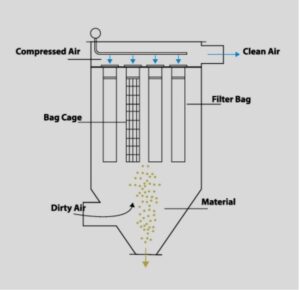The bag material or fabric media is crucial part of dust collector design and selection, as it determines the life and effectiveness of the filter bag. Fabric filter media must be compatible both physically and chemically with the gas stream and system conditions. Filter bags play crucial role in emissions from the bag filters. Emissions as low as 10mg/cm can be achieved by appropriate selection of filter fabric.
Pulse-jet dust collector consists of one or more isolated compartments containing rows of fabric bags in the form of cylindrical bags, or pleated cartridges. Dust particles along with air passes up along the surface of the bags then radially through the filter media. Particles are retained on the upstream face of the bags, and the cleaned gas stream is vented to the atmosphere. Each row of the filter bag is pulsed when the pressure-drop across the bags increased above certain limit. When the bags are pulsed, the material is deposited in the hopper, further it is discharged through RAL (Rotary Airlock Valve). The layer of dust (dust cake), collected on the fabric is primarily responsible for high efficiency of 99.9% for particles sizing in microns.

Working of Pulse Jet Dust Collector
Selection of filter bags incorporates following factors
Fineness of dust, moisture
Temperature
Dust type
Chemical properties
Dust diameter
Permeability of fiber
Dust abrasive property
Installation
Fabric’s resistance to cleaning energy
Fabric’s flexibility to allow rippling or stretching
Which is best suitable filter bag fabric for your application?
There is wide variety of filter fabrics used in pulsejet bag filter like Polyester, Polypropylene, Acrylic, PTFE, Aramid, Ryton, Glass-fibre, and Ceramics. There are various special type of coatings applied on these filter fabrics depending on application. If the temperatures up to 260°C, then the glass fibre bags are best suitable. Various application demands filter fabrics suitable for oily, moist, explosive, or fine particle air separation. Hence, selecting filter fabrics plays crucial role in performance of bag filter.
Woven and Non-woven Filter Fabrics
Non woven: fabrics are usually entangled together rather than being woven. It has good strength and are sutaible for agreessive applications like pulse jet bag filters.
Woven materials have threads wound in uniform, repeating patterns. This construction is used for low intensity cleaning methods such as reverse air and lower-intensity shakers. The weave pattern affects the strength of the fabric and the permeability/capture efficiency of the filter.
Different types of Treatments on Filter Bags
PTFE Member: A thin laminate of teflon is thermally bonded to the outside of the filter bag. PTFE membrane is used to improve the filtration efficiency and the cake release ability of the filter bag. The PTFE membrane fabric is relatively expensive, fragile and care must be taken when handling and installing this type of filter bag. The PTFE membrane can be added to most types of fabric filter media and offers the optimum filtration efficiency.
Singed In this process, surface of loose fibre ends are exposed to an open flame to melt ends to which dust particles could stick. This bag is excellent in releaseing cake from filter surface.
Calendering This process is also called as glazed. Felts are passed through two heated rollers and can also compress the felts to smooth the surface and improve dust cake release.
Fire Retardant Chemical sprayed on surface of the filter fabric, designed to reduce the probability of a spark igniting. The treatment does not fire proof the filter media, but offers protection against an occasional spark.
Acid Resistant Sprayed surface of the filter fabric on improving media fabrics ability to resist acid attacks.
Antistatic A stainless steel grid patterned scrim is manufactured inside the felted fibers of the media. Anti-static design exceeds standards for static dissipation media. Due to the unique design and proprietary needling technology, the probability for product contamination is eliminated.
Filter bags are efficiently used in following applications

Did you know?
With an experience of 46+ years, RIECO’s Clean Air Systems have catered to the requirements of 3000+ happy customers across the globe in their Steel, Power, Oil and Gas, Food, Spices, Pharma, and many more requirements with our state-of-art inhouse filter bag manufacturing facility
To learn more about Rieco Filter Bags, visit us at rieco@rieco.com

